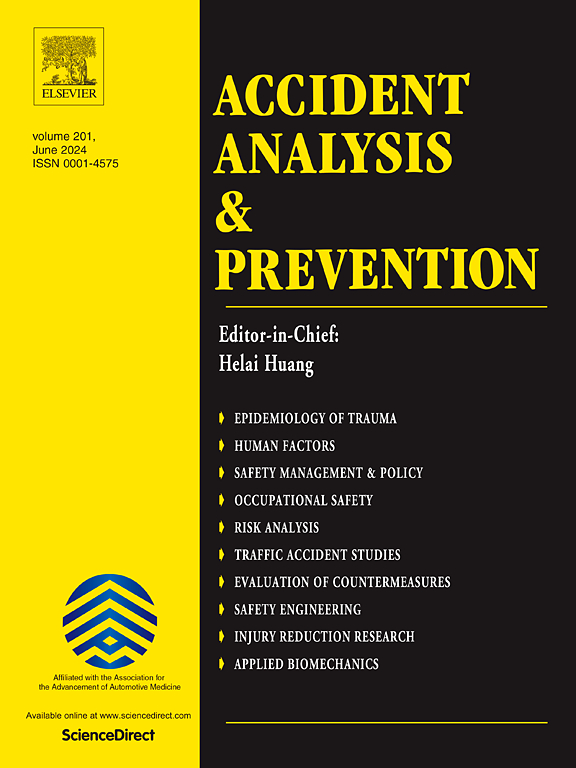Quantifying spatial inequities in traffic injury rates through the integration of urban road network measures and social vulnerability
IF 5.7
1区 工程技术
Q1 ERGONOMICS
引用次数: 0
Abstract
Mitigating traffic injury rate plays an essential role in sustainable urban development and is closely related to public health and human well-being. The inequity of traffic injury rate undermines equitable access to transportation infrastructure and poses a significant threat to the safety of residents during their commutes. Although previous studies have examined the association between socio-demographic characteristics and regional traffic crash risk, they seldom consider the spatial heterogeneity of the traffic injury rate inequity especially for the vulnerable groups. This study tackles three main challenges in quantifying spatial inequity in traffic injury rate, including identifying appropriate spatial units for macro-level crash modelling, integrating network topology measures, and examining the inequities suffered by vulnerable group. The global-scale spatial lag model (SLM) and local-scale geographically weighted regression (GWR) were employed at the census tract, Voronoi diagram and grid cell levels in New York City. The results highlight significant spatial variations in social vulnerability, showing that vulnerable indicators of housing cost burden, older age, minority, and those living in mobile homes are linked to increased traffic injury rate, especially in urban core regions. Furthermore, network topology measures indicates that increased network complexity and the buildings density would increase traffic injury rate. The traffic injury rate inequity level of each region was evaluated to identify areas with significant inequities for prioritization in future traffic planning. Recommendations like subsidized traffic insurance rates, enhanced public transportation services, and educational campaigns tailored for vulnerable groups are proposed. By prioritizing the needs of vulnerable groups and addressing the structural factors contributing to traffic injuries, policymakers can create safer and more equitable urban environment.
通过整合城市道路网络措施和社会脆弱性量化交通伤害率的空间不平等。
降低交通伤害率对城市可持续发展具有重要作用,与公共健康和人类福祉密切相关。交通伤害率的不公平破坏了交通基础设施的公平利用,对居民上下班的安全构成了重大威胁。以往的研究虽然考察了社会人口特征与区域交通碰撞风险之间的关系,但很少考虑交通伤害率不平等的空间异质性,尤其是弱势群体。本研究解决了量化交通伤害率空间不平等的三个主要挑战,包括确定宏观层面碰撞建模的适当空间单元,整合网络拓扑测量,以及检查弱势群体遭受的不平等。采用全球尺度空间滞后模型(SLM)和局地尺度地理加权回归(GWR)对纽约市的人口普测区、Voronoi图和网格单元水平进行了研究。结果表明,住房成本负担、老年人、少数民族和居住在移动房屋中的人的脆弱性指标与交通伤害率的增加有关,特别是在城市核心地区。此外,网络拓扑测量结果表明,网络复杂性和建筑物密度的增加会增加交通伤害率。评估了各区域的交通伤害率不平等程度,以确定未来交通规划中存在显著不平等的区域。建议包括补贴交通保险费率、加强公共交通服务以及针对弱势群体的教育活动。通过优先考虑弱势群体的需求并解决导致交通伤害的结构性因素,政策制定者可以创造更安全和更公平的城市环境。
本文章由计算机程序翻译,如有差异,请以英文原文为准。
求助全文
约1分钟内获得全文
求助全文
来源期刊

Accident; analysis and prevention
Multiple-
CiteScore
11.90
自引率
16.90%
发文量
264
审稿时长
48 days
期刊介绍:
Accident Analysis & Prevention provides wide coverage of the general areas relating to accidental injury and damage, including the pre-injury and immediate post-injury phases. Published papers deal with medical, legal, economic, educational, behavioral, theoretical or empirical aspects of transportation accidents, as well as with accidents at other sites. Selected topics within the scope of the Journal may include: studies of human, environmental and vehicular factors influencing the occurrence, type and severity of accidents and injury; the design, implementation and evaluation of countermeasures; biomechanics of impact and human tolerance limits to injury; modelling and statistical analysis of accident data; policy, planning and decision-making in safety.
 求助内容:
求助内容: 应助结果提醒方式:
应助结果提醒方式:


